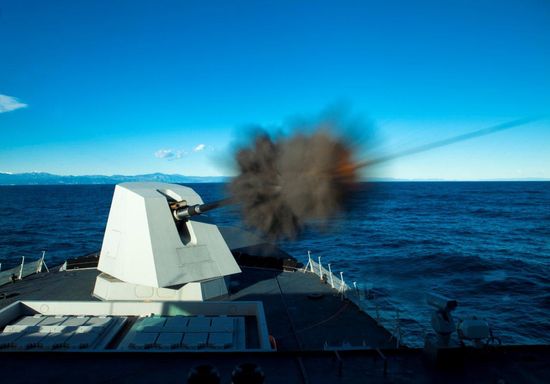
Manufactured by OTO-Melara, this is an upgraded 127 mm/54 (5") LW mounting with a 64 caliber barrel. This weapon will have a reduced ROF compared to the 54 caliber version, supposedly to allow for better control.
The LW (for "Light Weight") mounting uses four modular automatic feeding drum magazines, each holding 14 rounds. This permits firing up to four different and immediately selectable types of ammunition. The magazines can be reloaded while the gun is firing. Projectiles and propelling charges are hoisted separately to the gun level from below-deck feeding magazines. There is a composition station below the gun where the next round to be fired is selected just before it is taken up by the gun automatic loading system. Unfired rounds can be recycled back to the loading drums.
The mounting uses a water-cooled barrel, normally using sea water, but requiring fresh water for flushing after firing.
An interesting new munition for these guns is being developed by OTO-Melara. Called "Vulcano," this is a fin-stabilized, sub-caliber, extended range projectile which does not use rocket boost. Additional details below in the Ammunition section.
A press release by Finmeccanica dated 04 April 2007 announced that OTO-Melara had been awarded a contract by German BWB, the procurement arm of the ministry of defense, to supply five 127 mm/64 LW (Light Weight) naval systems. Four will be installed on the new F125 frigates while the fifth will be used for training.
On 5 December 2012 the Frigate Carlo Bergamini fired 54 rounds in the waters of La Spezia Gulf. This was the first time the 127/64 Lightweight Gun System had been fired on a naval warship.
In April 2020 the Dutch Defense Material Organisation (DMO) announced that it has selected Italian company Leonardo to supply new 127 mm/64 (5") naval gun systems for the Royal Netherlands Navy's four De Zeven Provinciën class LCF frigates. These will replace the older 127 mm/54 (5") mountings currently in use on these ships.
| Designation | 127 mm/64 (5") LW |
|---|---|
| Ship Class Used On | Germany: F125 class Frigates
Italy: Carlo Bergamini class Frigates Netherlands: de Zeven Provinciën class Frigates (as rearmed) |
| Date Of Design | 2004 |
| Date In Service | 2012 |
| Gun Weight | N/A |
| Gun Length oa | N/A |
| Bore Length | about 320.0 in (8.128 m) |
| Rifling Length | N/A |
| Grooves | N/A |
| Lands | N/A |
| Twist | N/A |
| Chamber Volume | N/A |
| Rate Of Fire | 32 rounds per minute |
| Type | Separate |
|---|---|
| Projectile Types and Weights 1 2 3 | Mark 80 HE-PD: 67.6 lbs. (30.7 kg)
Mark 91 Illum-MT: 63.9 lbs. (29.0 kg) Mark 116 HE-VT: 69.7 lbs. (31.6 kg) Mark 127 HE-CVT: 68.6 lbs. (31.1 kg) Mark 156 HE-IR: 69.0 lbs. (31.3 kg) |
| Bursting Charge | N/A |
| Projectile Length | Mark 80: 26 in (66 cm)
Mark 91: 26.1 in (66.3 cm) Mark 116: 26 in (66 cm) Mark 127: 26 in (66 cm) Mark 156: 26 in (66 cm) |
| Propellant Charge | Mark 67: 18.25 lbs. (8.3 kg)
Cartridge weighs 38.9 lbs. (17.6 kg) filled |
| Muzzle Velocity | 2,650 fps (808 mps)
Mark 91, only: 2,700 fps (823 mps) |
| Working Pressure | 18.5 tons/in2 (2,758 kg/cm2) |
| Approximate Barrel Life | 7,000 rounds |
| Ammunition stowage per gun | LW ready-use: 56 rounds in drums
Magazine: About 500 - 600 rounds |
- ^This weapon can use USN standard 5"/54 (12.7 cm) ammunition. The ones listed above are meant to be representational but by no means is this a complete listing.
- ^
Ammunition abbreviations HE-PD High Explosive, Point Detonating Fuze Illum - MT Illumination, Mechanical Time Fuze HE-VT High Explosive, Variable Time Fuze HE-CVT High Explosive, Controlled Variable Time Fuze - ^All projectiles have a 0.5 caliber boat-tail.
This is a fin-stabilized projectile and is essentially the OTO-Melara competitor to ERGM and BTERM, but the initial version does not use rocket boost and will be unguided. Greater range is to be achieved by increasing the muzzle velocity, which may reduce the barrel life. OTO-Melara states that Vulcano can be used by both Compact and LW mountings. Rounds will be sub-caliber with a sabot.
As of July 2011, OTO-Melara plans three versions of this munition. Using the standard 54 caliber barrel, these will be of the following types and ranges:
| Type | Range |
|---|---|
| Unguided multipurpose | Ballistic range of about 38 nm (70 km) |
| Terminally guided with on-board IR seeker for anti-ship engagements | Maximum of 38 nm (70 km) |
| Inertially guided system with GPS for NSFS role | Maximum of about 54 nm (100 km) |
Using the new 64 caliber barrel will increase these ranges by approximately 20 percent.
The Italian Army has decided to participate in the development of these munitions with the result that 155 mm versions will also be produced for the first and third variation. The main difference in the land versions, apart from the caliber, is the propelling charge configuration which has been specifically designed for compatibility with the PzH2000's loading system.
Rounds with GPS and INS guidance are expected to achieve a CEP of less than 66 feet (20 m). The NSFS and 155 mm munitions will include a laser-seeker.
According to Oto-Melara, the Vulcano program intends to provide warships with the capability to perform long-range precision bombardment against area targets with a radius of more than 250 meters (such as a tank company or a logistics installation), against point targets with a radius of around 100 meters (a brigade command post), and against precision targets (10-meter radius) such as bunkers or vehicles.
For this mode, Vulcano rounds will start a GPS/IMU (inertial measurement units)-controlled glide 60 sec. after firing, when they are 50 km. downrange and at the 18-km. apogee of their ballistic trajectories. They will perform a GPS/IMU-controlled terminal top-attack when above the target. The glide phase will typically last 140-230 sec.; the terminal attack phase 10 sec.
Oto-Melara also plans to equip a Vulcano variant with an infrared terminal seeker, providing long-range, precise anti-surface warfare capability against naval targets, including small fast-patrol boats. In this version, the Vulcano round starts looking for the target when overhead at an altitude of 2,500 meters (8,200 ft.). In both modes, the rounds carry a pre-fragmented semi-armor-piercing warhead.
System design requirements include a maximum effective range of 70 km. for the unguided munition, 100 km. for guided munitions fired from the 54-caliber gun, and 120 km. for guided munitions fired from the 64-caliber gun. Accuracy is said to be better than 20 meters; payload performance is designed to deliver 100 kg. (220 lb.)/min. over a 1-hr. sustained period, 200 kg./min. over a 3-min. period and 300 kg./min. over a 10-sec. salvo.
The Vulcano concept is based on a fin-stabilized projectile without rocket assistance. Range enhancement is achieved by greater muzzle velocity and improved aerodynamics compared with a full-caliber shell, Oto-Melara says. The Vulcano rounds will be compatible with existing loading systems (although the 127-mm./54-caliber Compact operated by the Dutch and the in-service Italian ships need minor modifications).
So far, live-firing tests show that the airframes designed for the Vulcano extended and long-range rounds create no anomalous wave pressures and have "good average muzzle velocity" of 1,070 meters/sec., Oto-Melara claims. Ranges of more than 48 km., with the apogee point at a range of 27.5 km. and an altitude of 10,500 meters (34,500 ft.), were achieved using a gun elevation of 33.5 deg. Wind-tunnel tests in Germany in 2006 looked at two designs for the canards that are used to control the round in its terminal phase, and tested the control actuation section under realistic pressure conditions.
In November 2011, OTO-Melara announced that the unguided ballistic version (BLR) would complete flight testing in 2013 with service introduction following in 2014. The guided round (GLR) is to complete flight testing in 2014 with service introduction planned for 2015. OTO-Melara also announced that a 76 mm version is now being planned.
| Elevation | Distance |
|---|---|
| 47 degrees | 25,290 yards (23,130 m) |
| Effective Range | 16,400 yards (15,000 m) |
| AA Range @ 83 degrees | 23,000 feet (7,000 m) |
| Illumination | 18,085 yards (16,540 m) 1a |
- ^Illumination rounds are automatically timed to ignite at an altitude of 1,050 feet (320 m) over the target area.
| Designation | Single Mountings
Italy Carlo Bergamini (1): 127 mm/64 LW Germany F125 (1): 127 mm/64 LW Netherlands De Zeven Provinciën (1): 127 mm/64 LW |
|---|---|
| Weight | 32 tons (33 mt) not including ammunition 1b |
| Elevation | -12 / +70 degrees |
| Elevation Rate | 30 degrees per second Acceleration: 40 degrees per second2 |
| Train | - / + 155 degrees |
| Train Rate | 40 degrees per second
Acceleration: 60 degrees per second2 |
| Gun recoil | N/A |
- ^Titanium is reportedly used to lower the mounting weight.
- The LW uses hydraulically operated feeding and loading systems. Servo systems are electric with plug-in modular electronics. This mounting requires 440V, 3-phase, 60 Hz <180 kVA for the main circuit and 115V, 1-phase, 400 Hz, 300 VA, for the servo and synchro network. Drums can be reloaded while the gun is firing. Ammunition flow is reversible so that rounds can be automatically unloaded.
- There are two loading arms in the gunhouse and the system has a strikedown feature that can safely return any unfired round loaded into the chamber down to the loading drum.
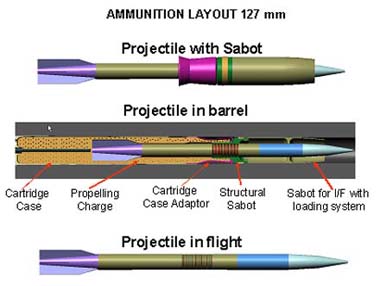
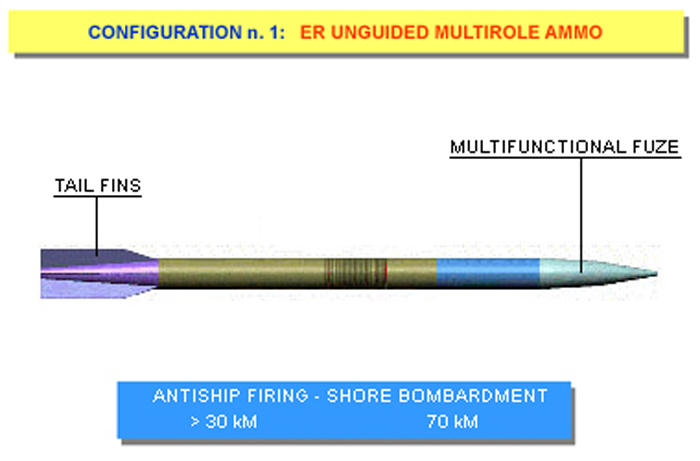
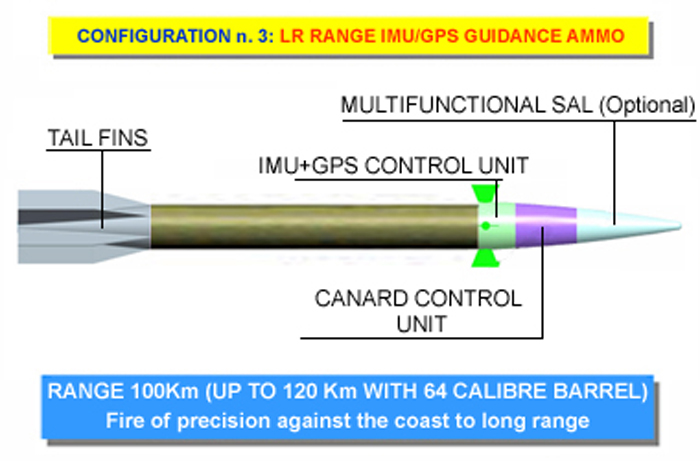
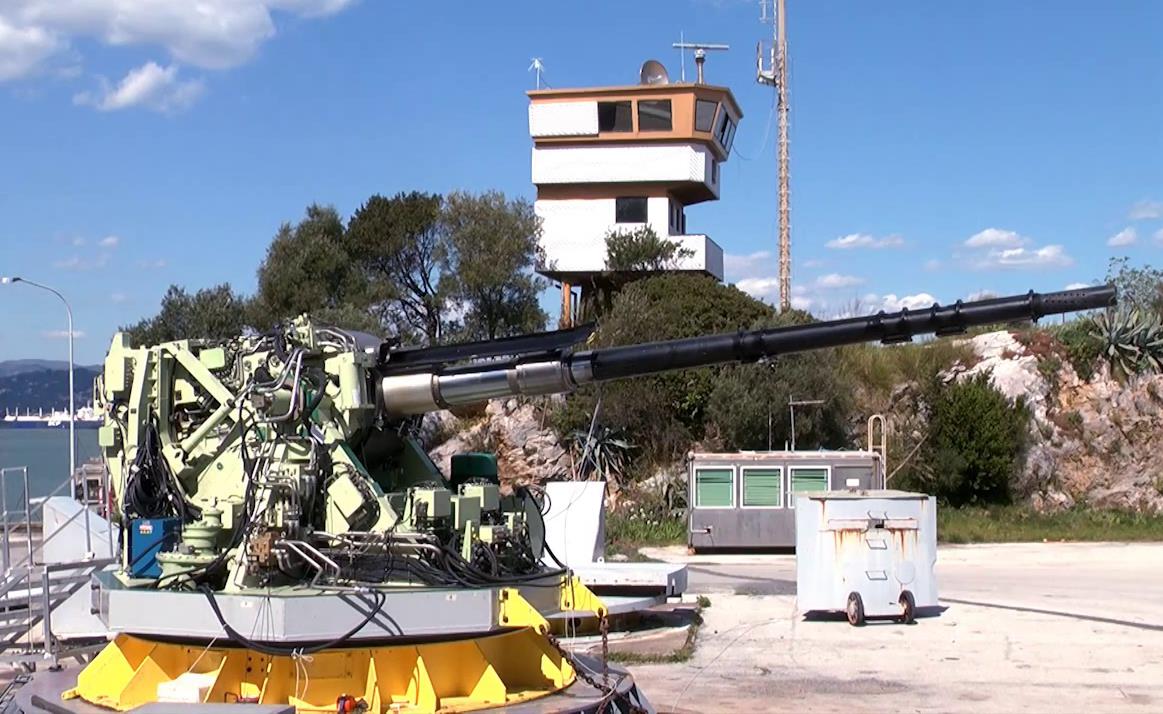

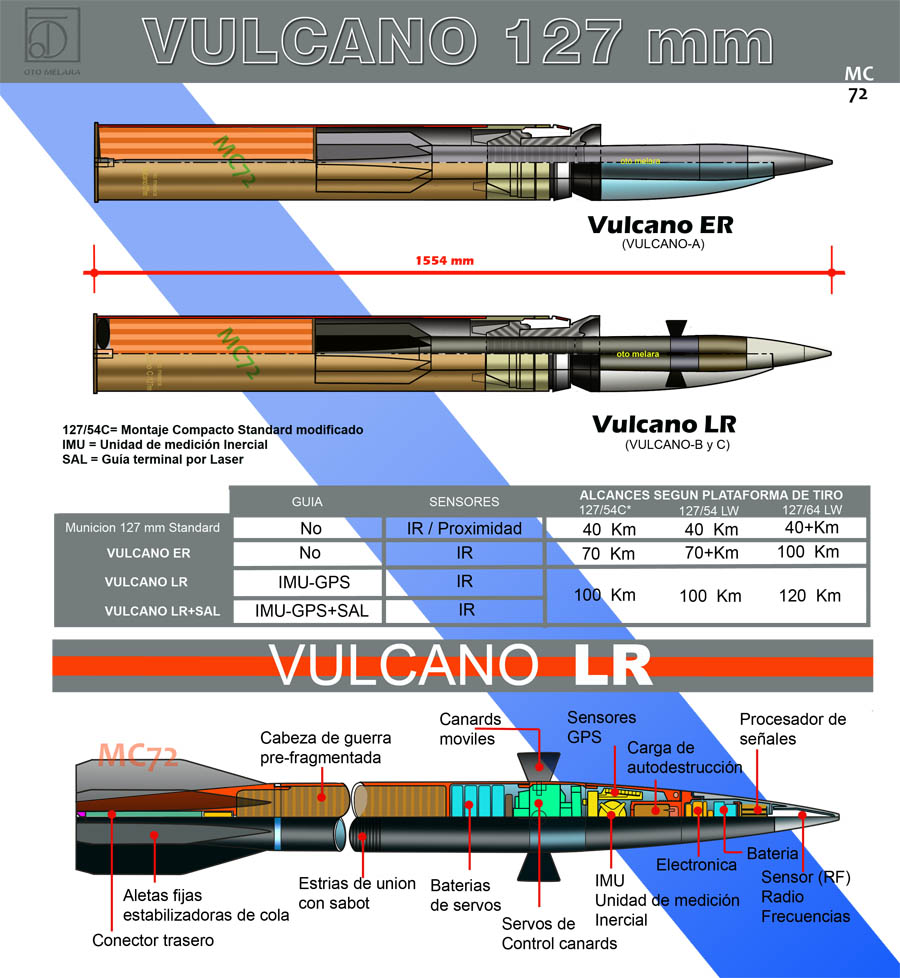
OTO-Melara Press Releases and 127/64 LW Datasheet
"Long Shots" article by Bill Sweetman in September 2007 issue of Defense Technology International Magazine
"Rangefinders: Oto-Melara blends performance and economy in land and sea guns" article by Andy Nativi in November 2011 issue of Defense Technology International Magazine
---
NAVSEA 5-inch Gun Ammunition Fact Sheets
---
Video of 127 mm/64 LW on firing range
Naval News "Leonardo to Supply New 127mm Main Guns for Netherlands Navy’s LCF Frigates"
---
Special help by Leo Fischer and Patrick Vera
17 April 2008 - Benchmark
19 September 2011 - Added Vulcano pictures and information
06 November 2011 - Updated Vulcano section
14 December 2012 - Added note about Italian Frigate Carlo Bergamini
01 January 2014 - Made additional pictures page
08 July 2015 - Added mounting details
21 November 2017 - Added Vulcano diagram
25 August 2020 - Added Netherlands Navy use
